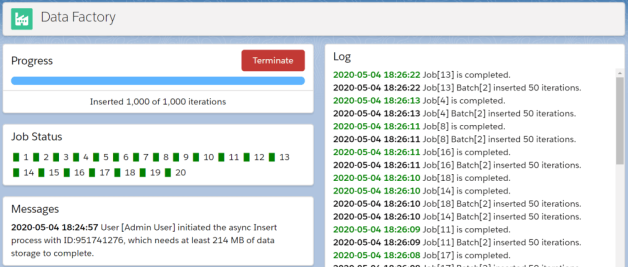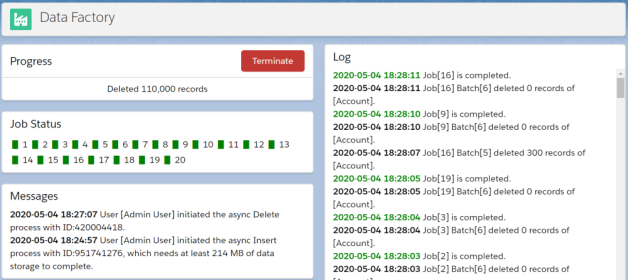This is a contributor post. For any question, please contact me for more details.
Salesforce DevOps is the amalgamation of software development and IT operations. It aims to speed up the development cycle, enabling continuous, high-quality software delivery.
In Salesforce DevOps, sandboxes and scratch orgs are essential as they provide isolated environments for development, testing, and staging without disrupting the production environment.
By facilitating continuous integration, delivery, and collaboration, these tools align with the core principles of DevOps, streamlining the application lifecycle from development to deployment.
Understanding Salesforce DevOps
Salesforce DevOps assists in developing and deploying Salesforce applications. It enables organizations to deliver applications and services rapidly and efficiently.
By promoting collaboration between developers and operations teams, DevOps practices help reduce the time to move from code committed to successfully running production.
Critical Components of Salesforce DevOps
- Continuous Integration and Delivery (CI/CD): This is a critical aspect of Salesforce DevOps, where developers frequently commit code to a shared repository, and automated builds and tests are run. Continuous delivery extends this by automatically deploying code to production after it passes tests, ensuring that code is always in a deployable state.
- Automation: In Salesforce DevOps, automation eliminates manual efforts, reduces errors, and speeds up processes. It is used in testing, deployment, and monitoring to ensure consistent and error-free operations.
- Infrastructure as Code (IaC): This practice involves managing and provisioning computing infrastructure through machine-readable scripts rather than manual processes. It promotes consistency and scalability in the infrastructure.
- Monitoring: Monitoring tools track application performance, usage, errors, and other metrics. This data is essential for maintaining system health and for making informed decisions.
- Cultural Changes: Salesforce DevOps is not just about tools and technologies; it also involves a cultural shift. This includes breaking down silos between development and operations teams, fostering collaboration, promoting ownership, and encouraging continuous learning and improvement.
Image Source: Salesforce
Process and Workflow in Salesforce DevOps
The Salesforce DevOps process typically involves several stages, each with specific workflows:
- Plan: This includes defining the requirements, designing the solution, and planning the work.
- Code: Developers use Salesforce’s development tools and environments to code the solution. Code is version-controlled, typically using Git.
- Build and Test: Code is built into a release and tested. Automated tests are used to verify that the solution works as expected.
- Deploy: The release is deployed to a staging environment for further testing and review. Once approved, it’s deployed to the production environment.
- Operate: The application is monitored, and any issues are addressed. User feedback is gathered for future improvements.
- Learn and Improve: Data from the operation phase and user feedback are used to learn and improve the application and the development process.
Deep Dive into Salesforce Sandboxes
In Salesforce, a sandbox replicates your production environment for testing and development. It provides a space where developers can safely experiment, build, and test changes without affecting the live application.
4 Types of Sandboxes in Salesforce:
- Developer sandboxes: Created explicitly for coding and testing purposes, allowing a single developer to work with a copy of the organization’s configuration without any production data.
- Developer Pro: Developer Pro sandboxes are similar to Developer sandboxes but provide more storage. They’re designed to handle more extensive development and testing tasks and accommodate larger teams.
- Partial Copy: Contain your organization’s metadata and a sample of your production data. They are used for complex testing and training purposes.
- Full: Full sandboxes are a complete copy of your production org, including all data and metadata. They are used for performance testing, load testing, and staging.
How to Use Sandboxes in Salesforce Development
Salesforce Sandboxes are used for development, testing, and training without compromising the data and functionality of the production environment.
Here are the steps to use sandboxes in Salesforce development:
- Create or refresh a Sandbox: Based on the requirements, create or refresh a sandbox using (Developer, Developer Pro, Partial Copy, or Full).
- Develop and Test: Developers make the necessary changes and additions in the sandbox environment, including creating new features, customizing existing ones, or fixing bugs. Once the changes are made, they can perform unit tests to ensure everything works as expected.
- User Acceptance Testing (UAT): After the developer’s testing, the business users or QA team can review and test the changes.
- Deploy to Production: After successful UAT, the changes can be deployed to the production environment using change sets, Salesforce CLI, or any third-party CI/CD tool.
Image Source: Salesforce
Benefits and Limitations of Using Sandboxes
There are benefits and limitations to using Sandboxes. Knowing them can help your team utilize them to their full potential:
| Benefits | Limitations |
| Different teams can use multiple sandboxes for simultaneous development and testing. | Keeping Sandboxes synchronized with the production environment can be challenging. |
| Sandboxes can train users and test real-world scenarios without impacting live data. | The number of available sandboxes depends on your Salesforce edition and the licenses you have. |
| A safe environment to develop and test changes without affecting the live production environment. | Full and Partial Copy sandboxes have specific refresh intervals (29 days and 5 days, respectively), which can limit their usability in specific scenarios. |
In-depth Understanding of Salesforce Scratch Orgs
Salesforce Scratch Orgs are temporary environments that can be fully customized to mirror different Salesforce editions with varying features and preferences. As part of Salesforce DX, Scratch Orgs are source-driven, disposable deployments of Salesforce code and metadata.
Setting up and Configuring Scratch Orgs
Setting up a Scratch Org involves these steps:
- Install Salesforce CLI: Salesforce Command Line Interface (CLI) is a powerful tool required to create and manage Scratch Orgs.
- Authenticate Dev Hub: You must authenticate with your Dev Hub org before creating a Scratch Org. Dev Hub is the central hub that controls creating and provides services for Scratch Orgs.
- Create a Scratch Org: After authentication, you can create a Scratch Org using the “sfdx force:org:create” command.
- Push Source to Scratch Org: You then push your source into the Scratch Org using the “sfdx force:source:push” command.
Image Source: Salesforce
Use Cases and Best Practices for Scratch Orgs
Here are a few use cases and best practices:
- Feature Development and Testing: Scratch Orgs are perfect for developing and testing a new feature or bug fix. Each developer can have their own Scratch Org to work independently.
- Continuous Integration and Continuous Delivery: Scratch Orgs can be used in CI/CD pipelines where automated tests are run in a Scratch Org to ensure code quality.
- Source-Driven Development: One best practice with Scratch Orgs is to always pull changes from the Scratch Org to keep the version control system current.
- Dispose after use: As Scratch Orgs are temporary, dispose of them after developing or testing to effectively manage the available Scratch Orgs.
Benefits and Limitations of Scratch Orgs
There are benefits and drawbacks to Scratch Orgs that developers must be aware of.
| Benefits | Limitations |
| Scratch Orgs provide isolated environments that can be tailored to match specific development needs. | Scratch Orgs are temporary, and keeping track of changes if they’re not correctly pulled into source control can be a challenge. |
| They support a source-driven development model | The number of active Scratch Orgs you can have depends on your Salesforce DX edition and licenses. |
| Scratch Orgs are ideal for automated testing and continuous integration, which promotes rapid, reliable releases. | The shift from org-based to source-driven development with Scratch Orgs can be a steep learning curve for some developers. |
Relative Analysis of Sandboxes and Scratch Orgs
The following analysis overviews the similarities and differences between Sandboxes and Scratch Orgs.
- Environment for Testing and Development: Sandboxes and Scratch Orgs are isolated environments used for development and testing. They allow developers to create, modify, and test features without affecting the production environment.
- Replication of Production Environment: Sandboxes and Scratch Orgs replicate your production environment. They can be configured to mimic different Salesforce editions with different features and preferences.
Differences between Sandboxes and Scratch Orgs
Choosing between these tools can be complex, but knowing the difference can help make your decision.
| Sandboxes | Scratch Orgs |
| Include production data (based on the sandbox type.) | Scratch Orgs are empty environments that don’t contain any data from your production org. |
| No expiration | Limited lifespan (maximum of 30 days) |
| Used for multiple stages of development, including development, testing, staging, and training. | A source-driven development model where changes are tracked in a version control system. |
Use Cases for Each: When to Use Sandbox v.s Scratch Org
The following cases state which tool best suits a specific task.
- Sandbox: Use Sandboxes for tasks that require persistence and longer-term stability. Sandboxes are ideal for final-stage testing, performance testing, user training, and for staging environments for quality assurance. They are also helpful when you need a copy of your production data for development and testing.
- Scratch Org: Use Scratch Orgs for short-term tasks, such as developing new features or testing the impact of changes. They are best suited for individual developers or teams following a source-driven development model. They are also suitable for automating unit tests and implementing continuous integration/delivery pipelines.
Role of Sandboxes and Scratch Orgs in Salesforce DevOps
Continuous Integration (CI) regularly merges code changes into a central repository. Both Sandboxes and Scratch Orgs play a critical role in CI. Developers can use Sandboxes or
Scratch Orgs to create and test features before integrating them into the main codebase. Scratch Orgs are particularly useful for CI because they’re easily made, disposed of, and can be aligned to specific user stories or tasks, enabling isolated testing and reducing potential conflicts.
Role in Continuous Delivery and Continuous Deployment
Continuous Delivery and Continuous Deployment extend CI by automating the release of changes to staging or production environments. Sandboxes can serve as staging environments for these releases, allowing final testing and review before deployment to production.
On the other hand, Scratch Orgs can be incorporated into delivery pipelines to automate the creation of temporary environments for testing. This ensures that code is always in a deployable state, reduces the risk of deployment failures, and speeds up the delivery process.
How Sandboxes and Scratch Orgs Enhance Collaboration and Efficiency
Sandboxes and Scratch Orgs promote a collaborative approach to development. Multiple developers can work simultaneously in different Sandboxes or Scratch Orgs without affecting each other’s work.
Scratch Orgs are tied to source control, allowing easy tracking of changes and facilitating collaboration across distributed teams. The ability to quickly set up, test, and dispose of Scratch Orgs boosts efficiency. With their persistence, Sandboxes allow for extended collaboration over longer project timelines.
Impact on Testing and Quality Assurance
Testing and quality assurance is integral to the software development lifecycle. Sandboxes enable developers to test new features in an environment closely mirroring production. The ability to copy production data (in Full and Partial Copy sandboxes) allows for realistic and robust testing.
Scratch Orgs, being fully configurable, can mimic very specific testing scenarios, providing an environment for fine-grained, accurate tests. By utilizing these tools, developers can catch and fix issues early, ultimately enhancing the quality of the application.
Conclusion
In conclusion, Salesforce Sandboxes, and Scratch Orgs are critical assets in the Salesforce development environment, enabling safe, flexible, and efficient application creation, testing, and deployment.
The Salesforce DevOps landscape, enriched with the complexities and ever-expanding features of Sandboxes, Scratch Orgs, and the Salesforce DX framework, offers a rewarding journey for novice and experienced developers.
Understanding and mastering these tools is pivotal in delivering robust, high-quality applications and fostering continuous learning, growth, and impactful contributions within your organization.



